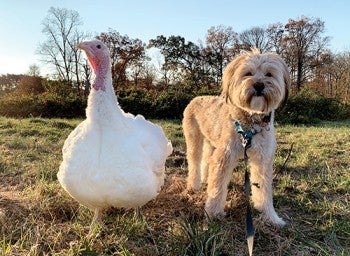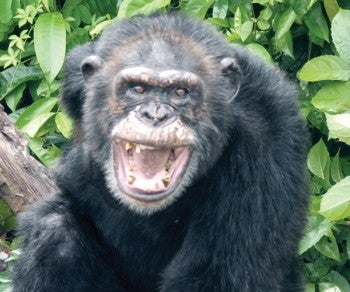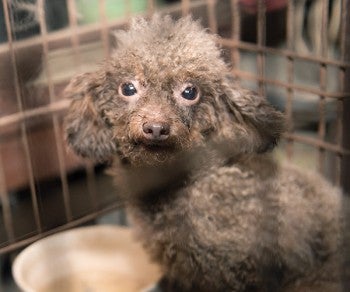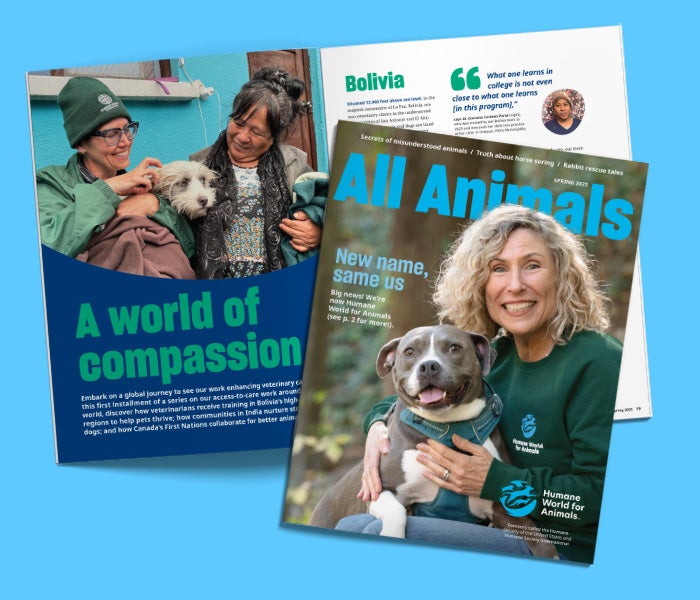Minnow
It makes sense that her best friends are turkeys. Minnow spent the first five months of her life on a dog meat farm in South Korea before she was rescued by Humane Society International in 2015 and adopted by Abbie Hubbard, who worked at a Virginia shelter where the rescued dogs were flown. Hubbard’s rescued turkeys were also once on their way to being eaten. First Minnow bonded with Blossom, who came from a factory farm. Now she hangs with Rosie. And she welcomes every foster or adopted animal Hubbard brings to her rural Virginia home: kittens; two parrots and a parakeet; two gerbils, who Minnow let crawl over her; and chickens, including a juvenile rooster whom she allowed to sleep in her tail and ride on her back. “Minnow’s a friend to everyone,” Hubbard says. “That’s her thing.”
Tiny Tina
Maybe she was the runt of the litter. Or perhaps she was stunted. Whatever the reason, the little black cat rescued in 2019 with around 200 others from a home in Killeen, Texas, was so small for a month-old kitten, she earned the name “Tiny Tina” when she leapt out of a cage and into the arms of Jenn Cherry, a member of our Animal Rescue Team. Breathing through her mouth, with a runny nose and gummed-up, infected eyes—the right one crusted shut—Tiny Tina was rushed to a veterinarian. Moved by the little cat’s need, rescue and response volunteer Denise Folcik adopted her.
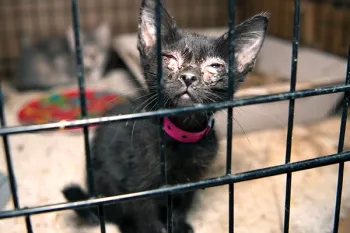
Meredith Lee/The HSUS
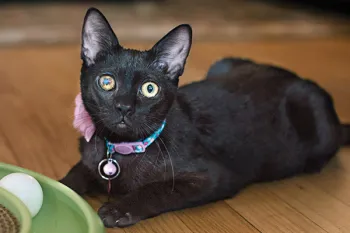
Alyssa Schukar/AP Images for the HSUS
Not too long after Tiny Tina arrived in Folcik’s home in Waukesha, Wisconsin—after her respiratory and eye infections cleared, leaving only a scar on her right cornea, and a case of ringworm was successfully treated—the sweet, cuddly little cat was transformed. Folcik has five other cats—all males—and a big mixed-breed dog named Pongo. Tiny Tina rules. “She has a huge, huge, huge attitude. She struts around like she’s a queen,” Folcik says. As Tina passes Folcik’s big silver Persian, she swats him. She walks casually between Pongo’s legs and touches his nose. She tears toy mice off their strings and carries glitter balls to Folcik to throw again and again so she can fetch—as many as 20 times in a row. She is so over her unfortunate early days.
Cherry has a tattoo on her arm of Tiny Tina piloting a plane. The picture includes the names of two kittens from the same rescue who did not make it. “Tiny Tina is my little survivor.”
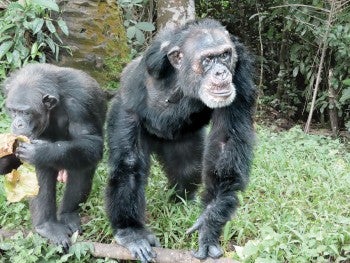
Jamie Linder/The HSUS
Now, 44-year-old Bullet—and the other chimps living in what is now HSI’s Second Chance Chimpanzee Refuge Liberia—is used to eating twice a day and is relaxed when caregivers arrive. He stands apart from the other chimps and mimes for what he wants—pineapple, papaya, bananas, mangoes, oranges. He methodically carries his food to a pile, unhurried, knowing no one will steal from him: The younger chimps defer to him, even though he has no teeth. He sits and eats calmly. Sometimes Lolo, the group’s alpha male, will run toward Bullet in what looks like a display of dominance, but at the last second Lolo will jump over the older chimp, turn and hug him.
Richard Ssuna, director and senior veterinarian at the refuge, says Bullet presides like an elder over the island’s other chimps. “He is self-assured,” says Ssuna. “He is quite aware that he is a highly respected individual in the group.” Life is good.
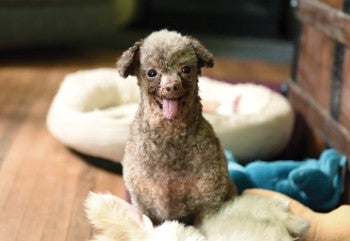
Amie Chou/The HSUS
Eve
Never in her former life had Eve the black bear seen one: a tiger in the grass. Earlier this year, as a rescued big cat named India moved in next door at Black Beauty Ranch, our sanctuary in Texas, 3-year-old Eve followed her instincts and climbed her favorite Southern pine to get a safe look. The bear had started her life in Northern California. But a bad case of mange left her furless and suffering from a fungal infection and weight loss. Captured on Christmas Eve of 2017, Eve “the Bare Bear” was taken to a wildlife center near San Diego. In December 2019, when it became clear her coat wouldn’t fully regrow and she wouldn’t survive in the wild, she was moved to the sanctuary, where she has neighbors not usually found in California or Texas and a half acre of woods to roam.
Eve no longer looks naked. Sun-bleached light brown fur has regrown thickly between her shoulders and along her back. She’s healthy and, after senior animal caregiver Christi Gilbreth sat near her enclosure during the early days at the sanctuary, confident and secure. Her favorite foods: canteloupe and honeydew melons. Her favorite game: pouncing on the drain of her pool so the pressure builds and the recirculating water shoots up from a spout. When Russell—a 2-year-old black bear who arrived at the sanctuary with his mother in the fall of 2020—sneaks up on Eve from his adjoining enclosure, she huffs and stomps her feet until he backs off. She can’t return to the wild, but a bit of the wild has returned to her.

Chris Headworth/Fund for Animals Wildlife Center
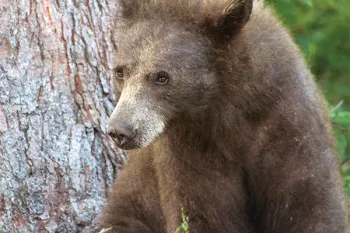
Maura Flaherty/The HSUS
Jonas
It took a lot to win Jonas’ affection after HSUS rescuers pulled him from a feces-encrusted crate in the basement of an old house in western Pennsylvania in 2019. Skinny, with a sunken face and rotting teeth, Jonas looked as though he wanted human attention. But whenever anyone opened the door of his cage at the temporary shelter, Jonas rushed to the back. Over time, he came out to play with other cats. Then one day, after about four months, rescuer Jenn Cherry returned from time off to find Jonas in the arms of his caregiver, Ariel Galinskas, snuggling into her shoulder, letting her pet him and brush him. “Jonas was finally like, ‘This is one of my people.’ ”
Jonas and the other cats had more than the usual time with Ariel and the other caregivers. A pending neglect case required them to be held as evidence while the case against their owner proceeded, and the COVID-19 pandemic slowed down the legal process. Fed from a spoon and treated with catnip, he gained weight and relaxed. Monday was puzzle day, Friday grooming day, Saturday all the toys came out for party day and Sunday was nap day. Every day, caregivers played soothing music and gave him hugs.
After 18 months, Jonas was on his way to being adopted when a veterinarian discovered a tumor deep in his throat that was causing him to drool more and more and would soon make it difficult for him to swallow. He would have to be euthanized. The news hit Cherry hard. Everything they had been working for gone. But then she realized that at the temporary shelter, Jonas had finally known love. “The last year and a half of his life was phenomenal. He was our baby.” They had given him his happily ever after.

Meredith Lee/The HSUS
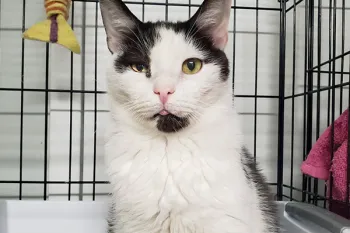
Tiffany McBee/The HSUS

